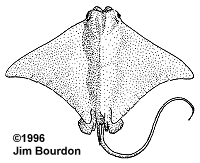| |
 When Bigelow & Schroeder (1953) published their research, they pointed out that it could be argued that Rhinoptera should be included as a myliobatid, and that other than teeth, distinguishing individual species was difficult. The bilobed snout is distinctive, but it otherwise conforms with the myliobatoid design -- a rhombic disk, long slender tail, single dorsal fin in the pelvic region and one or more barbed spines at the base of the tail. The skin is smooth on some species, and others have small prickles. These are medium-sized rays, reaching a width of two meters, which are known to school. Rhinoptera is represented in all oceans, and prefers the sandy or muddy bottoms of shallow waters where it forages for various mollusks and large crustaceans. FishBase recognizes eight valid taxa; only one, Rhinoptera bonasus (MITCHILL, 1815) is reported from the North Atlantic. When Bigelow & Schroeder (1953) published their research, they pointed out that it could be argued that Rhinoptera should be included as a myliobatid, and that other than teeth, distinguishing individual species was difficult. The bilobed snout is distinctive, but it otherwise conforms with the myliobatoid design -- a rhombic disk, long slender tail, single dorsal fin in the pelvic region and one or more barbed spines at the base of the tail. The skin is smooth on some species, and others have small prickles. These are medium-sized rays, reaching a width of two meters, which are known to school. Rhinoptera is represented in all oceans, and prefers the sandy or muddy bottoms of shallow waters where it forages for various mollusks and large crustaceans. FishBase recognizes eight valid taxa; only one, Rhinoptera bonasus (MITCHILL, 1815) is reported from the North Atlantic.
 The teeth are numerous -- they loosely interlock, and the files number from 5 to 19 depending on species (fig. ). The important features revealed by the dentitions are the varying degrees of elongation that can be seen and the hexagonal shape. Note that the lower lateral teeth of the illustrated Rhinoptera bonasus (fig. & ) extend at an angle from the median file. This orientation is reflected in isolated teeth (fig. ) by the non-perpendicular (to the crown) roots.
The teeth are numerous -- they loosely interlock, and the files number from 5 to 19 depending on species (fig. ). The important features revealed by the dentitions are the varying degrees of elongation that can be seen and the hexagonal shape. Note that the lower lateral teeth of the illustrated Rhinoptera bonasus (fig. & ) extend at an angle from the median file. This orientation is reflected in isolated teeth (fig. ) by the non-perpendicular (to the crown) roots.
Rhinoptera Fossil Record
There is no shortage of fossil examples of this tooth-design. Cappetta (1987:173) included:
R. prisca WOODWARD 1907 Palaeocene of Brazil,
R. raeburni WHITE 1934B Palaeocene of central Africa,
R. sherboni WHITE 1926A Middle Eocene of central & western Africa,
R. studeri (AGGASSIZ 1843B) Widely present in Miocene sediments.
Noubhani & Cappetta (1997:139) added Rhinoptera sp to the Ypresian of Morocco.
In the Western North Atlantic, they tend to become common in the Ypresian and appear to have maintained a healthy presence into recent times. Kent (1999:45-46) reported R. sherboni form the Ypresian of Virginia.
Muller (1999:64-65) included:
R. sp Piney Pt Fm , (Lutetian) VA
R. aff bonasus from the Belgrade, Calvert, Choptank & Pungo River Fms (Oligo-Miocene)
R. aff brasiliensis MULLER 1835 from the Old Church, Belgrade, Calvert, Choptank & Pungo River Fms (Oligo-Miocene) of VA & NC
Purdy et al (2001:95) consider the teeth found in Pungo River (units 1-5) as Rhinoptera sp.
Lee Creek Rhinoptera Teeth
There appears to be two variations which are best differentiated by the nature of the longitudinal (apico-basal) ridges of the labial and lingual faces of the crown. When this page was first published, the two tooth-designs were referred to as types "R" and "S"; it is now concluded that these differences represent differing upper and lower tooth-designs.
Type "R" -- Rhinoptera sp. -- Uppers (Fig. )
Although only represented by smaller, isolated teeth, these are by far the most common ray teeth found when surface collecting the mine. When I first started collecting at Aurora, I perceived them as index fossils. When I came across one, it meant that 'real' fossils were likely in that area.
Crowns. The crowns are clearly hexagonal in shape and may be slightly to strongly elongated depending on tooth position. The height of each lateral end is relatively similar, and any observed slope extends from one end to the other. The variable width-to-depth ratios manifested by the teeth of this family often allow for easy identification (as to genus). The middle region of the labial crown face projects labially, in tenon-fashion, and fits into a depression (mortise) on the lingual face of its anterior counterpart. These interlocking faces have weak apico-basal grooves or ridges which clearly distinguish these teeth from the myliobatids.
Roots. When viewed laterally, the loblets are generally centered relative to the root stem, extending slightly to the front and back and not reaching the lingual edge of the crown. In addition, the labial edge of the loblets is generally perpendicular to the base of the crown, lacking the strong slant associated with the myliobatids. The lingual face of the root stem generally lacks foramina; the basal face usually reveals a few, and the labial face has numerous foramina above the loblets and just below the crown's overhang. Certain lower teeth, when viewed basally, have loblets which are oriented at an angle that is not perpendicular to the face of the crown, a characteristic of some Rhinoptera lateral teeth (fig. ).
Type "S" -- Rhinoptera sp. -- Lowers (Fig. )
These teeth are similar to Type "R" in overall design, but have crowns and roots which differ significantly enough to be included as a unique tooth-design.
Crowns. The labial face is more upright, lessening the tenon and mortise design so apparent in Type "R". The weakening of this crown interlocking mechanism has been compensated for by the stronger and more angular apico-basal ridges and grooves of each face -- an improved suture design. The labial face of each tooth is now positioned over the adjoining tooth's lingual ledge.
Roots. The roots, particularly the loblets, have also changed. They are now positioned to the rear and extended to the lingual margin of the collar. The labial face of each loblet has a slight depression to accommodate the loblets of their anterior counterpart.
Selected References
Bigelow, H. & Schroeder, W., 1953. Part 2. Sawfishes, Guitarfishes, Skates and Rays; Chimaeroids in; Fishes of the western North Atlantic. Sears Foundation for Marine Research, Yale University, New Haven.
Cappetta, H., 1987. Chondrichthyes II: Mesozoic and Cenozoic Elasmobranchii. Handbook of Paleoichthyology, 3B. Gustav Fischer Verlag, Stuttgart and New York, 193 pp.
Müller, A. 1999. Ichthyofaunen aus dem atlantischen Tertiär der USA. Leipziger Geowissenschafteb, Leipzig, 9/10: 1-360.
Purdy, R., Schneider, V., Appelgate, S., McLellan, J., Meyer, R. & Slaughter, R., 2001. The Neogene Sharks, Rays, and Bony Fishes from Lee Creek Mine, Aurora, North Carolina. In: Geology and Paleontology of the Lee Creek Mine, North Carolina, III. C. E. Ray & D. J. Bohaska eds. Smithsonian Contributions to Paleobiology, No 90. Smithsonian Institution Press, Washington D.C. pp. 71-202.
|